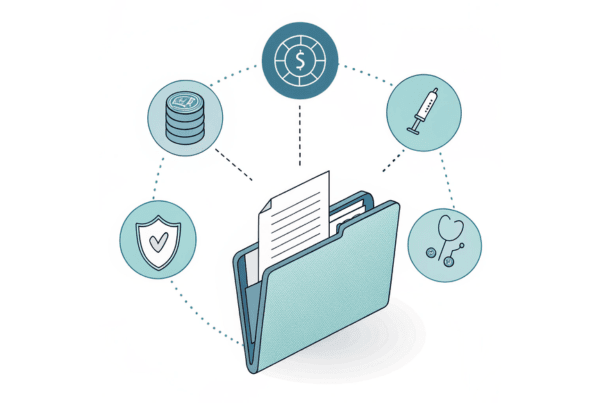The Indianapolis hospice care market is experiencing significant growth, creating a powerful opportunity for practice owners considering a sale. However, navigating this landscape, with its increasing private equity interest and regulatory oversight, requires careful planning. This guide offers you clear insights into the current market, valuation drivers, and the key steps to ensure a successful and rewarding transition for your practice.
Your Position in the Indianapolis Hospice Market
The market for hospice care in Indianapolis is strong, reflecting a robust national trend. For practice owners, understanding this landscape is the first step toward a successful sale. The environment is defined by a few key factors.
- A Substantial National Market. The U.S. hospice sector is valued at around $30 billion and continues to grow. This national tailwind directly benefits local practices in Indianapolis.
- Strong Medicare Demand. Nearly half of all Medicare decedents now receive hospice care. This shows a consistent and reliable demand for your services.
- For-Profit Sector Growth. Nationally, for-profit hospices have expanded significantly. This has drawn in sophisticated buyers and private equity groups who are actively looking for well-run practices.
This combination of factors means that buyers are actively seeking quality hospice acquisitions in markets like Indianapolis. Your practice is not just a local standalone business. It is a valuable asset in a dynamic national healthcare sector.
Key Considerations for a Successful Sale
Beyond the numbers, sophisticated buyers in Indianapolis look closely at the operational health of your hospice. A premium valuation depends on getting ahead of three specific areas of concern that we see in almost every transaction.
Regulatory Compliance
The Indiana Department of Health maintains strict oversight. Buyers will perform deep due diligence on your compliance history and documentation. Having your records in order is not just good practice. It is a core part of demonstrating a low-risk, high-value acquisition target.
Quality of Care
In a market with growing for-profit presence, demonstrating a commitment to quality is how you stand out. Positive patient outcomes, high satisfaction scores, and a strong community reputation are valuable assets that directly translate into a higher purchase price.
Staff Stability
With caregiver turnover in Indiana being a significant challenge, a stable, dedicated team is one of your most powerful selling points. We help owners frame their retention strategies and team culture as a key strength, mitigating a major concern for potential buyers.
A Look at Current Market Activity
The M&A market for hospice and home health is active, but it’s also changing. Knowing these trends helps you time and position your sale for the best outcome. Here is what we are seeing today.
- Consistent Deal Flow. While the number of transactions dipped slightly from a peak in 2022, the market remains robust with nearly 100 deals reported in the sector last year.
- Private Equity is the Primary Buyer. PE firms and their platform companies are the most aggressive buyers. They are looking for well-run practices to add to their growing networks.
- Regulatory Scrutiny is Increasing. Both federal and state regulators are reviewing healthcare transactions more closely, especially those involving private equity. This makes a clean, well-documented process more important than ever.
This environment means that while demand is high, buyers are more disciplined. They need to be confident in the practice they are acquiring. A professionally managed sale process gives them that confidence.
The Sale Process Unpacked
Selling your practice is a multi-step journey, not a single event. When we manage a sale, we move through a structured process designed to maximize value and minimize disruption to you and your practice. Many sales encounter problems during due diligence, but proper preparation can prevent these issues.
| Sale Phase | Key Objective |
|---|---|
| 1. Preparation & Valuation | Establish a clear, defensible valuation and prepare all financial and operational data for buyer review. |
| 2. Confidential Marketing | Identify and approach a curated list of qualified buyers without alerting staff, patients, or competitors. |
| 3. Due Diligence | Manage the flow of information to the chosen buyer, anticipate their questions, and navigate any challenges that arise. |
| 4. Closing & Transition | Finalize legal agreements and ensure a smooth transition of ownership that protects your legacy and staff. |
Each stage requires a different focus. A well-managed process ensures you move confidently from one to the next toward a successful closing.
How Your Hospice Practice is Valued
A common question we hear is, “What is my practice worth?” In hospice care, buyers look at value from a few different angles. While a rule of thumb is sometimes cited around $60,000 per patient in your census the real valuation comes from a deeper look at your business’s health and profitability.
The key metric is Adjusted EBITDA. This is your practice’s earnings before interest, taxes, depreciation, and amortization, with adjustments made for owner-specific expenses. This figure shows a buyer the true cash flow of the business. That Adjusted EBITDA is then multiplied by a number (a multiple) that is determined by several factors.
- Your Patient Census & Referral Network. A consistent, high-quality patient base with strong, diversified referral sources is a primary value driver.
- Profitability & Payer Mix. Healthy profit margins and a favorable mix of reimbursement sources demonstrate financial stability.
- Quality of Staff & Operations. A tenured, low-turnover staff and efficient operations reduce perceived risk for a buyer.
- Compliance & Accreditation. A clean record with the Indiana Department of Health is non-negotiable and supports a premium valuation.
Understanding your practice’s current market position is the first step toward a successful transition.
After the Sale: Protecting Your Legacy
The transaction is not the finish line. A truly successful sale is one where you feel secure about the future of the practice you built and your own next steps. This requires planning for what happens the day after the deal closes.
The Structure of the Deal
Many owners worry about losing control. But modern deals can include options like an equity rollover, where you retain a stake in the new company, or earnouts that reward you for future performance. These structures can keep you involved and provide significant financial upside.
Protecting Your Team
Your legacy is tied to the team and patients you served. The right buyer is one who shares your values. We help you negotiate terms that ensure continuity of care and protect your staff, preserving the culture you worked hard to build.
Your Next Chapter
The structure of your sale has major implications for your after-tax proceeds. Planning ahead allows you to transition into retirement or your next venture with financial confidence and peace of mind.
Frequently Asked Questions
What is the current market outlook for selling a hospice care practice in Indianapolis?
The Indianapolis hospice care market is strong and growing, benefiting from a robust national hospice sector valued at around $30 billion. There is consistent Medicare demand and increasing interest from for-profit hospices and private equity buyers, making it an opportune time for practice owners to consider a sale.
What are the key factors buyers consider when valuing a hospice care practice in Indianapolis?
Buyers focus on several valuation drivers including the patient census and referral network, profitability and payer mix, quality of staff and operations, and strict compliance with Indiana Department of Health regulations. The primary financial metric used is Adjusted EBITDA, which reflects true cash flow after removing owner-specific expenses.
How can I prepare my hospice care practice for a successful sale in Indianapolis?
Preparation involves ensuring regulatory compliance with thorough documentation, demonstrating high-quality care with positive patient outcomes and satisfaction scores, and maintaining staff stability with low turnover. A clear valuation and well-organized financial and operational data are critical for attracting sophisticated buyers and achieving a premium price.
What should I expect during the sale process of my hospice care practice?
The sale process typically includes four phases: (1) Preparation and Valuation, where you establish the practice’s value and prepare financial records; (2) Confidential Marketing, targeting qualified buyers discreetly; (3) Due Diligence, managing buyer inquiries and documentation requests; and (4) Closing and Transition, finalizing legal agreements and ensuring a smooth ownership transfer that protects your legacy and staff.
How can I protect my legacy and team after selling my hospice care practice?
Many contracts include options like equity rollovers or earnouts to keep you involved financially and operationally. It’s important to negotiate terms with buyers who share your values and will maintain continuity of care and staff culture. Planning the sale structure carefully also helps with financial confidence and a smooth transition to your next chapter.



